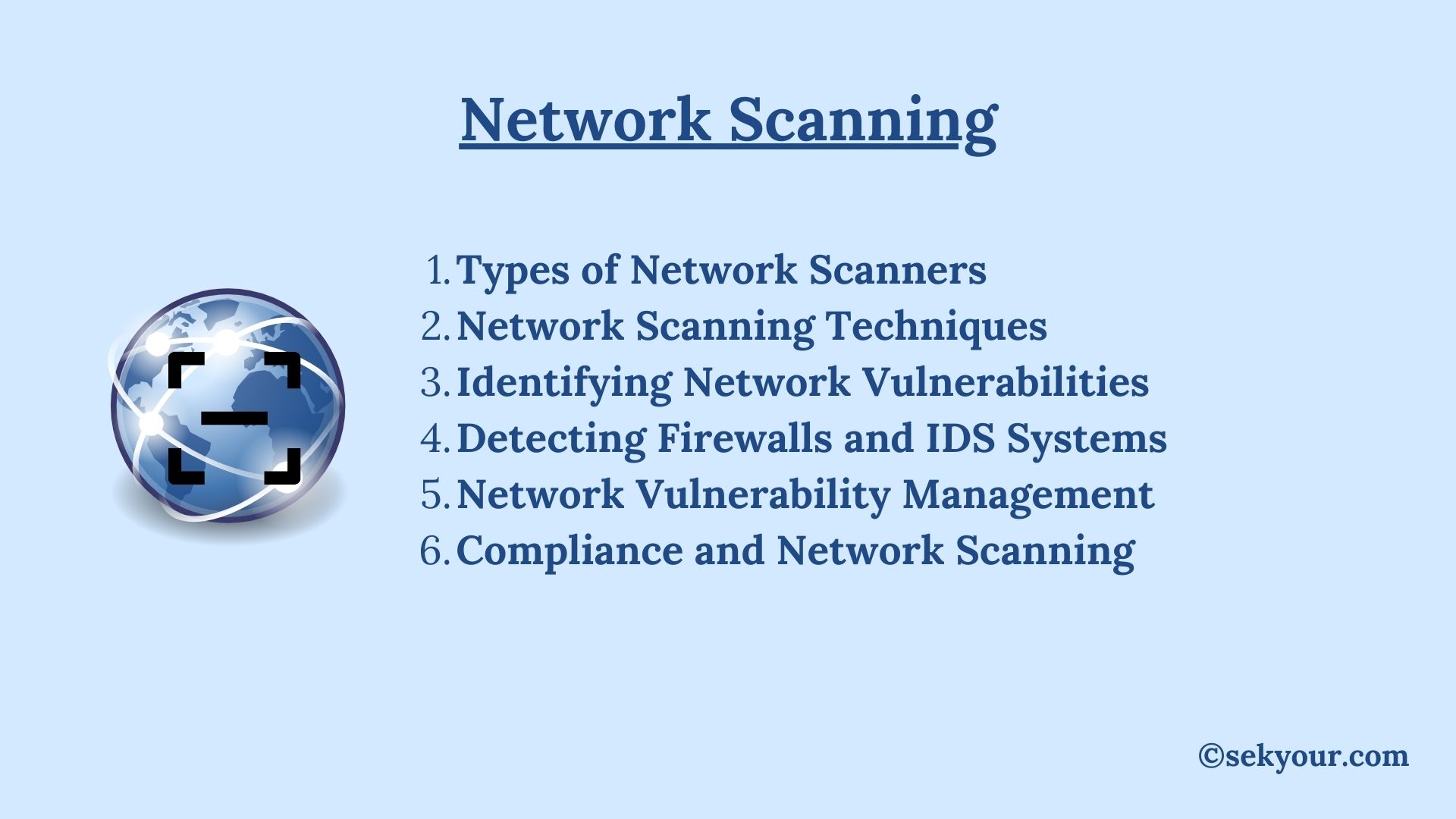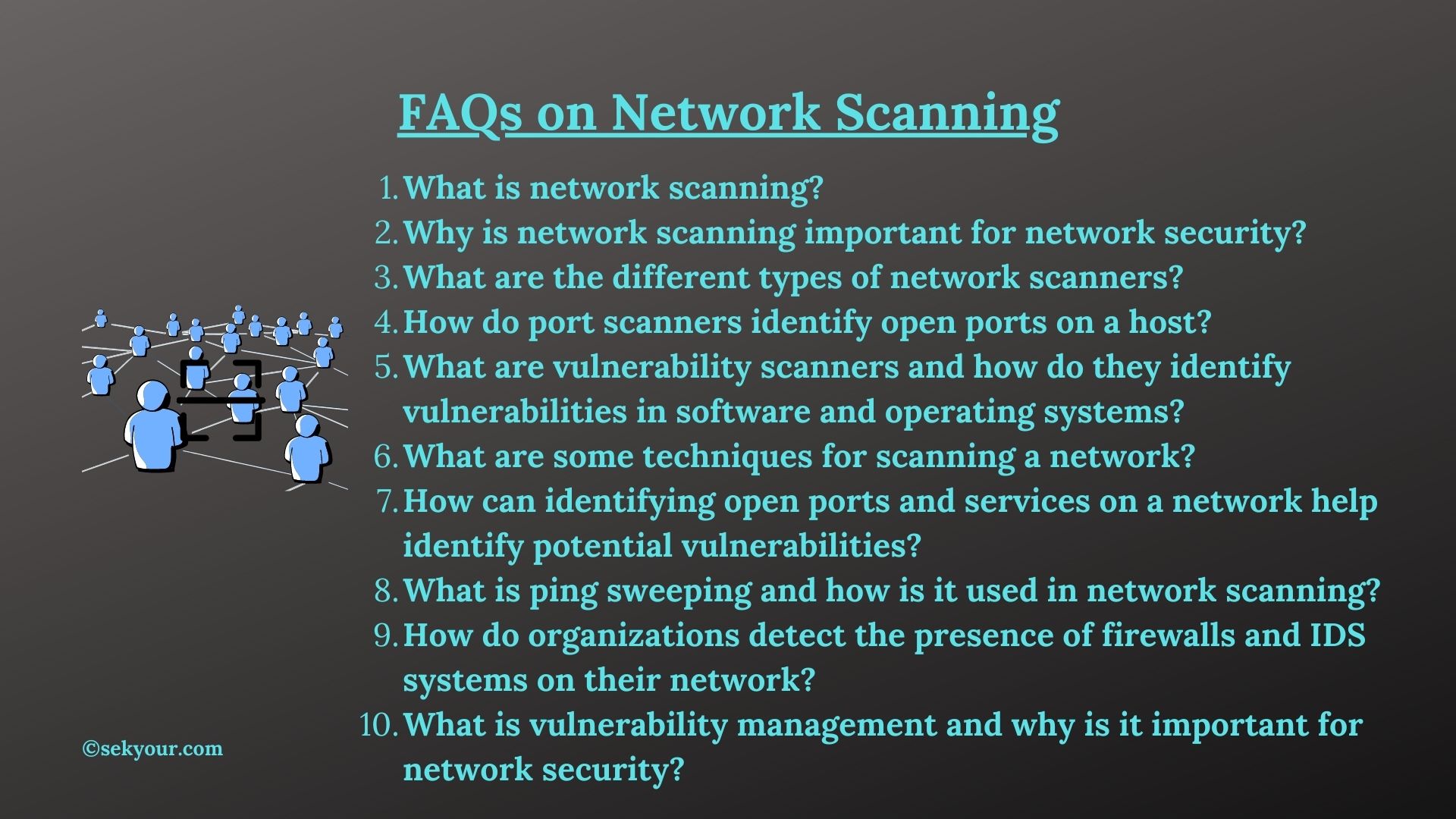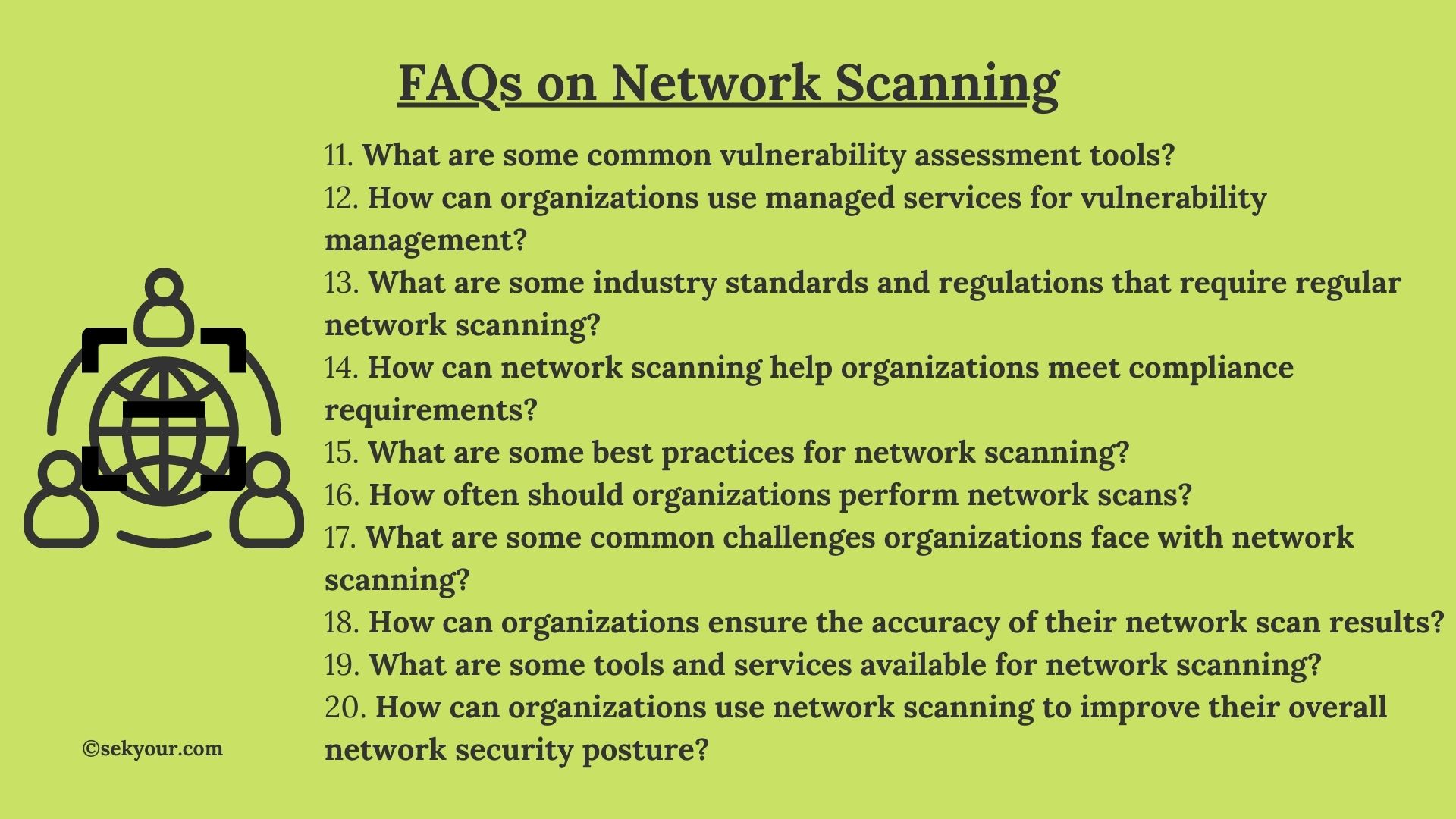1. Introduction
Network scanning identifies active hosts on a network and gathers information about their open ports and services.
Network scanning is an important aspect of network security as it identifies potential vulnerabilities and areas of the network that may be more susceptible to attack.
By regularly performing network scans, organizations can proactively detect and remediate security issues before malicious actors can exploit them. It also helps in compliance with industry standards and regulations by identifying any network vulnerabilities that need to be addressed. In short, network scanning enables organizations to maintain a secure and compliant network infrastructure.

2. Types of Network Scanners
Port scanners are network scanning tools that identify open ports on a host. These scanners send requests to specific ports on a host to determine if they are available, closed, or filtered. Port scanners identify the services running on a host and the software used. By identifying open ports, port scanners can help identify potential vulnerabilities and areas of the network that may be more susceptible to attack. A well-known open-source port scanning tool is Nmap.
Vulnerability scanners are another type of network scanning tool that identifies vulnerabilities in a host’s software and operating systems. These scanners use a combination of techniques, such as version detection, fingerprinting and vulnerability checks to identify known vulnerabilities in a system. Vulnerability scanners can also provide information on missing security patches and configuration issues. These scanners can help identify and prioritize vulnerabilities that need to be addressed. A well-known open-source vulnerability scanner is Nessus. A case study by the SANS Institute found that vulnerability scanners found an average of 69% more vulnerabilities than manual testing alone.
By using both Port scanners and Vulnerability scanners, organizations can have a more comprehensive understanding of their network and the potential vulnerabilities that exist.
3. Network Scanning Techniques
Ping sweeping is a technique used to identify active hosts on a network. It involves sending a ping request to a range of IP addresses to identify active ones. This technique is useful for identifying all devices connected to a network, including those that may not have a hostname or DNS entry. Ping sweeping can also be used to identify new devices that have been added to a network. A well-known open-source tool for ping sweeping is Fping.
As mentioned, Port scanning is a technique used to identify open ports on a host. It involves sending a request to a specific port on a host to determine if it is open, closed, or filtered. Port scanning is used to identify what services are running on a host and the type of software used. By identifying open ports, port scanning can help identify potential vulnerabilities and areas of the network that may be more susceptible to attack. A well-known open-source tool for port scanning is Nmap. According to a study by the SANS Institute, 99.9% of all networks have at least one open port that is not authorized.
Ping sweeping and Port scanning are two techniques that are commonly used together in network scanning. They can be used to identify all active hosts and services on a network and to identify potential vulnerabilities that need to be addressed.
4. Identifying Network Vulnerabilities
Identifying open ports and services on a network is an important aspect of network security. Open ports and services provide information about what services are running on a host and the type of software used. This information can be used to identify potential vulnerabilities and areas of the network that may be more susceptible to attack. For example, if a host has an open port for Telnet, it indicates that the host is running Telnet service, which is an insecure protocol and can be exploited. By identifying open ports and services, organizations can proactively detect and remediate security issues before they can be exploited by malicious actors.
Identifying potential vulnerabilities in a network is another important aspect of network security. Potential vulnerabilities can include missing security patches, misconfigurations, and known software and operating systems vulnerabilities. Malicious actors can exploit vulnerabilities to gain unauthorized access to a network, steal sensitive information, or disrupt operations. According to a study by the SANS Institute, vulnerability scanners found an average of 69% more vulnerabilities than manual testing alone. Organizations must perform vulnerability assessments regularly and address identified vulnerabilities promptly to maintain secure network infrastructure.
By identifying open ports and services and potential vulnerabilities, organizations can proactively detect and remediate security issues before malicious actors can exploit them. This can help organizations maintain a secure and compliant network infrastructure.
5. Detecting Firewalls and IDS Systems
Firewalls and Intrusion Detection Systems (IDS) are security measures implemented to protect networks from unauthorized access and malicious activities. Network scanners can be used to detect the presence of firewalls and IDS systems on a network. One method of detection is scanning for specific ports typically used by firewalls and IDS systems. Another method is to identify the presence of a firewall or IDS by its response to certain network packets. By detecting the presence of firewalls and IDS systems, organizations can gain insight into the security measures on their network.
Identifying the security measures on a network is an important aspect of network security. By understanding what security measures are in place, organizations can identify potential weaknesses and take steps to address them. For example, if a firewall or IDS is not properly configured, it may not provide the required level of protection. Additionally, if a firewall or IDS is not updated with the latest security patches, it may not be able to protect against the latest threats. It is important for organizations to regularly review and update their security measures to ensure that they are providing the level of protection that is required.
Detecting firewalls and IDS systems on a network can provide valuable information on the security measures in place and help identify potential weaknesses. This enables organizations to maintain secure network infrastructure and improve their overall security posture.
6. Network Vulnerability Management
Vulnerability assessment tools and software are used to identify and prioritize vulnerabilities on a network. These tools use a combination of techniques such as version detection, fingerprinting, and vulnerability checks to identify known vulnerabilities on a system. Some standard vulnerability assessment tools include Nessus, OpenVAS, and Qualys. These tools can be run on-demand or scheduled periodically to identify and address vulnerabilities promptly.
Vulnerability management services are another way to address vulnerabilities on a network. These services can include managed vulnerability scanning, vulnerability assessments, and penetration testing. These services are typically provided by security companies and can have not only the technical aspects of vulnerability management but also the expertise and experience of security professionals. These services can be helpful for organizations that need more resources or expertise to manage vulnerability management in-house. A case-study by the SANS Institute found that organizations that used vulnerability management services reduced the median time to remediation by 45%.
By identifying and addressing vulnerabilities on a network, organizations can proactively detect and remediate security issues before malicious actors can exploit them. This can help organizations maintain a secure and compliant network infrastructure.
7. Compliance and Network Scanning
Network scanning is an important aspect of compliance with various industry standards and regulations. These standards and regulations may require organizations to perform vulnerability assessments regularly and address identified vulnerabilities promptly. Examples of such standards and regulations include PCI-DSS, HIPAA, and NIST. Network scanning can help organizations identify vulnerabilities that must be addressed to meet these compliance requirements.
Compliance requirements can vary depending on the industry and the specific regulations that apply to an organization. For example, organizations that handle sensitive personal information, such as credit card numbers, may be required to meet PCI-DSS compliance requirements which mandate regular vulnerability assessments and penetration testing. Organizations that handle sensitive medical information may be required to meet HIPAA compliance requirements which mandate regular security risk assessments and address vulnerabilities. Compliance with these regulations requires organizations to understand their network and potential vulnerabilities comprehensively. Network scanning can help organizations to meet these compliance requirements.
Network scanning is essential to compliance with various industry standards and regulations. By identifying vulnerabilities and addressing them, organizations can meet the compliance requirements and maintain a secure network infrastructure. Regular network scanning can help organizations to identify vulnerabilities and address them promptly to meet compliance requirements.
8. Conclusion
Network scanning is an essential aspect of network security, it allows organizations to identify active hosts on a network, open ports and services, potential vulnerabilities, and security measures in place. Organizations can proactively detect and remediate security issues by regularly performing network scans before malicious actors can exploit them. Additionally, network scanning is an important aspect of compliance with various industry standards and regulations.
Various open-source and commercial tools and services are available for network scanning, such as Nmap for port scanning, Nessus for vulnerability scanning and Fping for ping sweeping. These tools can provide valuable information about a network and help identify potential vulnerabilities. Organizations can also use managed services for vulnerability management, including managed vulnerability scanning, vulnerability assessments, and penetration testing. These services are provided by security companies and can include not only the technical aspects of vulnerability management but also the expertise and experience of security professionals. Organizations should choose the tools and services that best fit their needs and budget.
In summary, Network scanning is a vital component of network security; it helps organizations to identify potential vulnerabilities and areas of the network that may be more susceptible to attack. Regular network scanning can help organizations maintain a secure and compliant network infrastructure. There are various tools and services available that organizations can use to scan their network and address any vulnerabilities that are identified.
9. FAQs on Network Scanning

1. What is network scanning?
Network scanning identifies active hosts on a network and gathers information about their open ports and services.
2. Why is network scanning important for network security?
Network scanning is important for network security as it identifies potential vulnerabilities and areas of the network that may be more susceptible to attack. By regularly performing network scans, organizations can proactively detect and remediate security issues before malicious actors can exploit them. It also helps in compliance with industry standards and regulations by identifying any network vulnerabilities that need to be addressed. In short, network scanning enables organizations to maintain a secure and compliant network infrastructure.
3. What are the different types of network scanners?
The different types of network scanners include port scanners and vulnerability scanners. Port scanners identify open ports on a host, while vulnerability scanners identify vulnerabilities in a host’s software and operating system.
4. How do port scanners identify open ports on a host?
Port scanners identify open ports on a host by sending requests to specific ports to determine if they are open, closed, or filtered. This information can be used to identify what services are running on a host and the type of software used. By identifying open ports, port scanners can help identify potential vulnerabilities and areas of the network that may be more susceptible to attack.
5. What are vulnerability scanners and how do they identify vulnerabilities in software and operating systems?
Vulnerability scanners are a type of network scanning tool that identifies vulnerabilities in a host’s software and operating systems. These scanners use a combination of techniques such as version detection, fingerprinting and vulnerability checks to identify known vulnerabilities on a system. Vulnerability scanners can also provide information on missing security patches and configuration issues. These scanners can help identify and prioritize vulnerabilities that need to be addressed.
6. What are some techniques for scanning a network?
Some techniques for scanning a network include ping sweeping, which involves sending a ping request to a range of IP addresses to identify which are active, and port scanning, which involves sending a request to a specific port on a host to determine if it is open.
7. How can identifying open ports and services on a network help identify potential vulnerabilities?
Identifying open ports and services on a network provides information about what services are running on a host and the type of software used. This information can be used to identify potential vulnerabilities and areas of the network that may be more susceptible to attack. For example, if a host has an open port for Telnet, it indicates that the host is running Telnet service which is an insecure protocol.
8. What is ping sweeping and how is it used in network scanning?
Ping sweeping is a technique used to identify active hosts on a network. It involves sending a ping request to various IP addresses to identify active ones. This technique is useful for identifying all devices connected to a network, including those that may not have a hostname or DNS entry. Ping sweeping can also be used to identify new devices that have been added to a network. A well-known open-source tool for ping sweeping is Fping.
9. How do organizations detect the presence of firewalls and IDS systems on their network?
Organizations can detect the presence of firewalls and IDS systems on their network by performing network scans and analyzing the results. Firewalls and IDS systems often have specific ports or protocols used for communication and management, network scanners can detect these ports and protocols and indicate the presence of these security systems. Additionally, some network scanners have specific checks or plugins to detect the presence of firewalls and IDS systems.
10. What is vulnerability management and why is it important for network security?
Vulnerability management identifies, classify, and mitigate network infrastructure vulnerabilities. It includes regular vulnerability assessments, identifying missing security patches and configuration issues, and implementing remediation plans. Vulnerability management is important for network security as it helps organizations to proactively identify and address vulnerabilities before malicious actors can exploit them.

11. What are some common vulnerability assessment tools?
Some common vulnerability assessment tools include Nmap, Nessus, and OpenVAS. These tools can be used for port scanning and vulnerability scanning, respectively.
12. How can organizations use managed services for vulnerability management?
Organizations can use managed services for vulnerability management to outsource the technical aspects of vulnerability management, such as vulnerability scanning and assessments, to security experts. These services can also include reporting and remediation recommendations. Managed services can provide organizations with the expertise and experience of security professionals and help organizations to address vulnerabilities more efficiently and effectively.
13. What are some industry standards and regulations that require regular network scanning?
Some industry standards and regulations that require regular network scanning include PCI DSS, HIPAA, and NIST SP 800-53. These standards and regulations all require organizations to assess and address vulnerabilities in their network infrastructure regularly.
14. How can network scanning help organizations meet compliance requirements?
Network scanning can help organizations meet compliance requirements by identifying vulnerabilities in the network infrastructure that need to be addressed. Organizations can proactively detect and remediate security issues by regularly performing network scans before malicious actors can exploit them. This can help organizations to maintain a secure and compliant network infrastructure.
15. What are some best practices for network scanning?
Some best practices for network scanning include regularly performing scans, using a combination of techniques and tools, and maintaining accurate and up-to-date asset inventory. Additionally, organizations should have processes in place for addressing vulnerabilities that are identified during a scan.
16. How often should organizations perform network scans?
The frequency of network scans will depend on the organization’s specific needs and risk profile. However, it is generally recommended that organizations perform regular scans at least every quarter. Additionally, organizations should perform scans whenever significant changes are made to the network infrastructure, such as the addition of new devices or updates to software.
17. What are some common challenges organizations face with network scanning?
Organizations' common challenges with network scanning include false positives, identifying the correct remediation action, and maintaining accurate and up-to-date asset inventory. Additionally, organizations can need help with the sheer volume of vulnerabilities identified during a scan and the resources required to address them.
18. How can organizations ensure the accuracy of their network scan results?
Organizations can ensure the accuracy of their network scan results by regularly updating their asset inventory, using a combination of techniques and tools, and validating scan results with manual testing. Additionally, organizations should have processes for verifying and validating vulnerabilities identified during a scan.
19. What are some tools and services available for network scanning?
Some popular tools and services available for network scanning include Nmap, Nessus, OpenVAS, and Fping. Additionally, there are a variety of commercial and open-source tools and services that organizations can use to perform network scans.
20. How can organizations use network scanning to improve their overall network security posture?
Organizations can use network scanning to improve their overall network security posture by identifying and addressing vulnerabilities in their network infrastructure. By regularly performing network scans, organizations can proactively detect and remediate security issues before malicious actors can exploit them. Additionally, network scanning can help organizations to maintain a secure and compliant network infrastructure, which can help to improve their overall security posture.